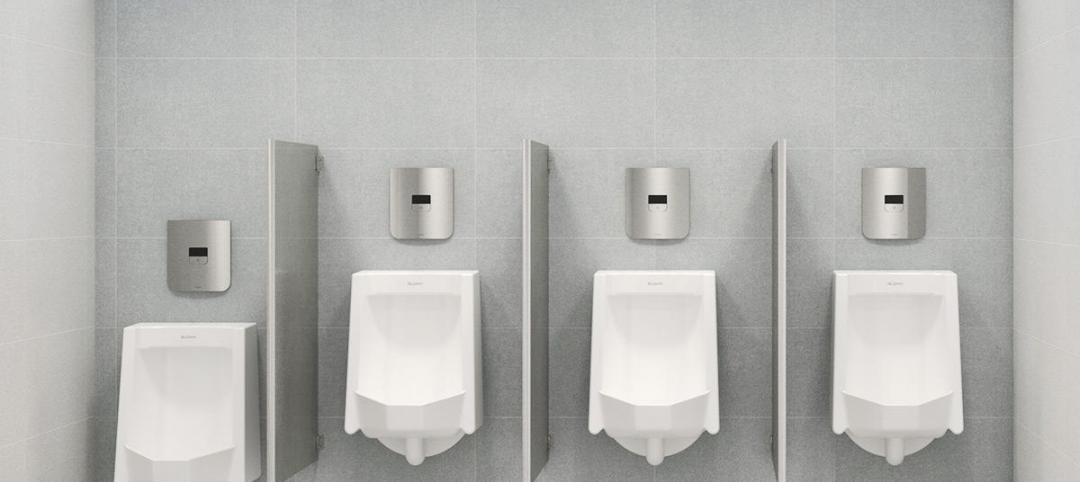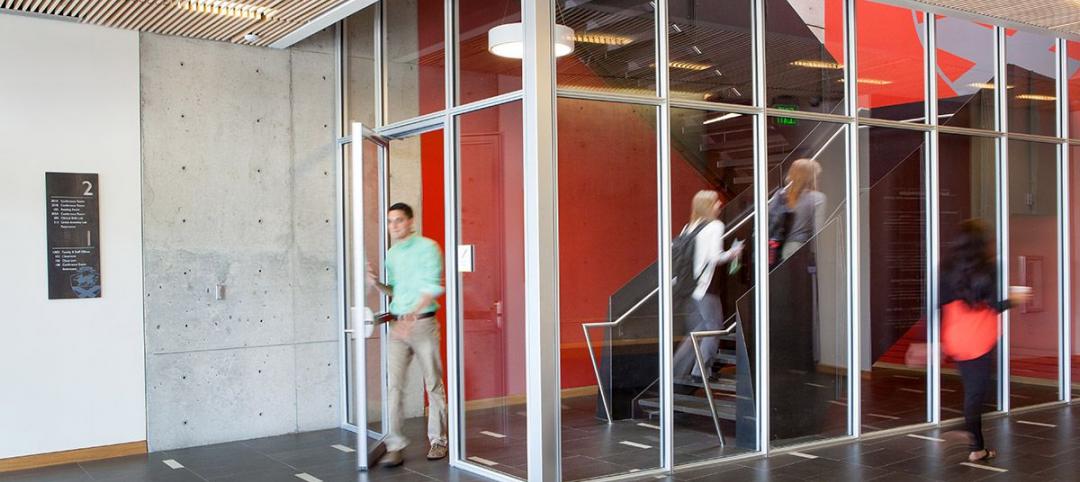Designed by Pietro Belluschi, the Juilliard School in New York’s Lincoln Center for the Performing Arts had remained relatively untouched since its completion in 1969. In the early 2000s, a plan was conceived to make Lincoln Center—and Juilliard—more architecturally engaged with the general public and its Upper West Side neighbors.
In an effort to offer additional educational opportunities to the growing number of students, officials at the school sought to add 39,000 sf of classrooms, practice rooms, and rehearsal spaces, as well as two new performance venues. The design also called for more informal social spaces for students and greater access to daylight, as well as an upgrade of the public entrance to integrate the building—a classic example of the Brutalist movement—more fully into the landscape of the Lincoln Center campus.
Renovating on the Upper West Side
Working with a Building Team that included a design collaboration between New York-based firms FXFOWLE Architects and Diller Scofidio + Renfro, engineering firms Arup and Langan Engineering & Environment Services, and Turner Construction Co., the administration sought to preserve the iconic elements of Belluschi’s design while meeting the needs of students and creating a more public identity for the building.
Numerous stakeholders had to be consulted—this is, after all, New York—from academic department heads to Lincoln Center’s 14 other constituent organizations, as well as the New York City Department of Planning, neighborhood and community boards, and the New York State Historic Preservation Office.
Moreover, the Building Team was to undertake the project while Juilliard remained fully occupied and functional. With an institution whose very soul relied on quality acoustics for its existence, mitigating sound during construction was a primal concern for the Building Team. “The challenge in renovating the antiquated, Brutalist space was to perform surgery on part of the building while still allowing full bodily function of the other organs,” says Heidi Blau, AIA, LEED AP, a partner at FXFOWLE.
PROJECT SUMMARY
The Juilliard School Renovation and Expansion, New York City, N.Y.
Building Team
Owner/developer: The Juilliard School
Architects: FXFOWLE Architects (submitting firm) and Diller Scofidio + Renfro
Structural engineer: Arup
Civil engineer: Langan Engineering & Environment Services
GC/CM: Turner Construction Co.General Information
Size: 39,000 sf
Construction cost: Confidential at owner’s request
Construction period: 2005 to 2010
Delivery method: CM
To meet these demands, a sophisticated plan of phasing, relocation, use of temporary facilities, and incremental reoccupation was developed. Blau says she envisioned the process as one “where one facet might undergo a transformation without disrupting the integrity of the project as a whole.” The use of swing space was an important strategy. For example, an infill interior courtyard was made into a temporary classroom; later, the space was converted to a permanent orchestra rehearsal room.
Opening up to the community
For more than four decades, the Juilliard building presented a fortress-like appearance to the surrounding community, a manifestation of the Brutalist design that Blau says “reflected a cloistered approach to the arts.” The Lincoln Center campus master plan called for a more open and inviting Juilliard.
The first step was to open up Juilliard’s entryway into a three-story lobby, thereby extending a warm welcome to visitors entering from 65th Street. The glass lobby connects spaces at street level, where many public programs are offered, to the student lounge on the second level and administration offices on the third. LED information boards, computer terminals, and a coffee bar invite more opportunities for students to meet and socialize; a glass box office is easily accessible to visitors and patrons. The lobby’s new grand staircase contains specially cut sections that provide communal spaces for those in transit from one floor to another, a feature that the BD+C Reconstruction Awards jury, notably juror Martha Bell, FAIA, found “very interesting.”
The façade, with its three-story glass curtain walls along Broadway, entices neighbors and passersby to look in, while at the same time projecting the school’s energy out into the community. The glass wall brings much more natural daylight into the school’s once dark, labyrinthine interiors.
Staying true to form
All this, while still retaining Belluschi’s stone details elsewhere on the exterior elevations. “The building façade includes more than 10 different types of glass in order to meet the distinct technical requirements of strength, acoustics, and thermal performance of the exterior wall,” says Peter Pesce, AIA, a senior associate at FXFOWLE. “Matching the original stone details while employing modern construction techniques proved challenging.”
Respecting the original Brutalist design was important to the Building Team. Travertine cladding was used from the very quarry where the original was mined, providing continuity of materials. Says Blau, “The careful surgery performed on Pietro Belluschi’s building was predicated on the existence of robust bones—able to support the transformation while retaining a significant portion of the existing travertine and concrete.”
Taking on the renovation of one of New York City’s cultural treasures required not only an appreciation for the original design, but also a sensitivity to the legitimate concerns of numerous stakeholders. The renovation and expansion of the Juilliard School has transformed the revered institution into a more modern performing arts center while preserving its architectural heritage. It is for these reasons that our Reconstruction Awards jury has designated this project as a Bronze winner. +
Related Stories
75 Top Building Products | Dec 16, 2019
Top Window and Door Products for 2019
Pella’s Rolscreen retractable screen and NanaWall’s HSW single-track sliding glass wall are among the 16 window and door products to make Building Design+Construction’s 2019 101 Top Products report.
75 Top Building Products | Dec 16, 2019
Top Structural Products for 2019
Inpro’s Fireline 140 fire barrier and Owens Corning’s Foamglas cellular glass insulation are among the 10 structural products to make Building Design+Construction's 2019 101 Top Products report.
75 Top Building Products | Dec 16, 2019
101 Top Products for 2019
Building Design+Construction readers and editors select their top building products for the past 12 months in the fourth-annual 101 Top Products report.
75 Top Building Products | Dec 16, 2019
Top Plumbing Products for 2019
Sloan's CX Flushometer and Zip Water's HydroTap are among the eight plumbing products to make Building Design+Construction's 2019 101 Top Products report.
75 Top Building Products | Dec 16, 2019
Top Interior Building Products for 2019
Arktura's Delta Drop ceiling and CertainTeed's Decoustics Rondolo wood panels are among the 13 new interior products to make Building Design+Construction's 2019 101 Top Products report.
75 Top Building Products | Dec 16, 2019
Top Glass and Glazing Products for 2019
SageGlass's Harmony dynamic glass and Vitro Architectural Glass's Acuity low-iron glass are among the nine new glass and glazing products to make Building Design+Construction's 2019 101 Top Products report.
75 Top Building Products | Dec 16, 2019
Top Flooring Products for 2019
Tarkett’s aviation-inspired flooring collection and J+J Flooring’s textile composite flooring are among the four new commercial flooring products to make Building Design+Construction’s 2019 101 Top Products report.
75 Top Building Products | Dec 16, 2019
Top Building Systems Products for 2019
FabricAir’s ceiling-hung fabric duct and Ellumi Lighting’s bacteria-killing lights are among the 13 new building systems products to make Building Design+Construction's 2019 101 Top Products report.
75 Top Building Products | Dec 12, 2019
Top Building Envelope Products for 2019
Sto's beetle-inspired exterior coating and Dörken Systems' UV-resistant vapor-permeable barrier are among the 28 new building envelope products to make Building Design+Construction's 2019 101 Top Products report.
Architects | Dec 10, 2019
Calling all emerging architects: Enter to win the $20,000 Forge Prize
This annual steel design competition will recognize three Finalists ($10,000 each) and one Grand Prize Winner ($20,000 total) for their novel concepts in steel-based structures. Entries are due Jan. 15, 2020.

















